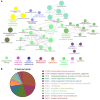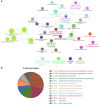Deep-Learning Algorithm and Concomitant Biomarker Identification for NSCLC Prediction Using Multi-Omics Data Integration
- PMID: 36551266
- PMCID: PMC9775093
- DOI: 10.3390/biom12121839
Deep-Learning Algorithm and Concomitant Biomarker Identification for NSCLC Prediction Using Multi-Omics Data Integration
Abstract
Early diagnosis of lung cancer to increase the survival rate, which is currently at a low range of mid-30%, remains a critical need. Despite this, multi-omics data have rarely been applied to non-small-cell lung cancer (NSCLC) diagnosis. We developed a multi-omics data-affinitive artificial intelligence algorithm based on the graph convolutional network that integrates mRNA expression, DNA methylation, and DNA sequencing data. This NSCLC prediction model achieved a 93.7% macro F1-score, indicating that values for false positives and negatives were substantially low, which is desirable for accurate classification. Gene ontology enrichment and pathway analysis of features revealed that two major subtypes of NSCLC, lung adenocarcinoma and lung squamous cell carcinoma, have both specific and common GO biological processes. Numerous biomarkers (i.e., microRNA, long non-coding RNA, differentially methylated regions) were newly identified, whereas some biomarkers were consistent with previous findings in NSCLC (e.g., SPRR1B). Thus, using multi-omics data integration, we developed a promising cancer prediction algorithm.
Keywords: biomarker; cancer prediction; deep learning; gene ontology enrichment; graph convolutional network; non-small-cell lung cancer.
Conflict of interest statement
The authors declare that they have no conflict of interest.
Figures






Similar articles
-
XL1R-Net: Explainable AI-driven improved L1-regularized deep neural architecture for NSCLC biomarker identification.Comput Biol Chem. 2024 Feb;108:107990. doi: 10.1016/j.compbiolchem.2023.107990. Epub 2023 Nov 23. Comput Biol Chem. 2024. PMID: 38000327
-
MoAGL-SA: a multi-omics adaptive integration method with graph learning and self attention for cancer subtype classification.BMC Bioinformatics. 2024 Nov 23;25(1):364. doi: 10.1186/s12859-024-05989-y. BMC Bioinformatics. 2024. PMID: 39580382 Free PMC article.
-
Enlightening the path to NSCLC biomarkers: Utilizing the power of XAI-guided deep learning.Comput Methods Programs Biomed. 2024 Jan;243:107864. doi: 10.1016/j.cmpb.2023.107864. Epub 2023 Oct 20. Comput Methods Programs Biomed. 2024. PMID: 37866126
-
[Non-small cell lung cancer. New biomarkers for diagnostics and therapy].Pathologe. 2015 Nov;36 Suppl 2:189-93. doi: 10.1007/s00292-015-0084-1. Pathologe. 2015. PMID: 26391246 Review. German.
-
Microbial biomarker development for detection and prognosis of early-stage non-small cell lung cancer.Cancer Biomark. 2025 Apr;42(4):18758592251322045. doi: 10.1177/18758592251322045. Epub 2025 Apr 29. Cancer Biomark. 2025. PMID: 40302376 Review.
Cited by
-
BAMBI integrates biostatistical and artificial intelligence methods to improve RNA biomarker discovery.Brief Bioinform. 2025 Mar 4;26(2):bbaf073. doi: 10.1093/bib/bbaf073. Brief Bioinform. 2025. PMID: 40121554 Free PMC article.
-
A 23-gene multi-omics signature predicts prognosis and treatment response in non-small cell lung cancer.Discov Oncol. 2025 Jul 23;16(1):1391. doi: 10.1007/s12672-025-03243-2. Discov Oncol. 2025. PMID: 40699399 Free PMC article.
-
Comparative Analysis of Multi-Omics Integration Using Graph Neural Networks for Cancer Classification.IEEE Access. 2025;13:37724-37736. doi: 10.1109/access.2025.3540769. Epub 2025 Feb 11. IEEE Access. 2025. PMID: 40123934 Free PMC article.
-
The Importance of Biomarker Testing in the Treatment of Advanced Non-Small Cell Lung Cancer: A Podcast.Oncol Ther. 2024 Jun;12(2):223-231. doi: 10.1007/s40487-024-00271-w. Epub 2024 Mar 27. Oncol Ther. 2024. PMID: 38536631 Free PMC article.
-
Novel research and future prospects of artificial intelligence in cancer diagnosis and treatment.J Hematol Oncol. 2023 Nov 27;16(1):114. doi: 10.1186/s13045-023-01514-5. J Hematol Oncol. 2023. PMID: 38012673 Free PMC article. Review.
References
Publication types
MeSH terms
Substances
Grants and funding
LinkOut - more resources
Full Text Sources
Medical

